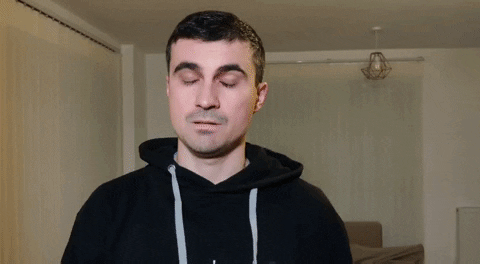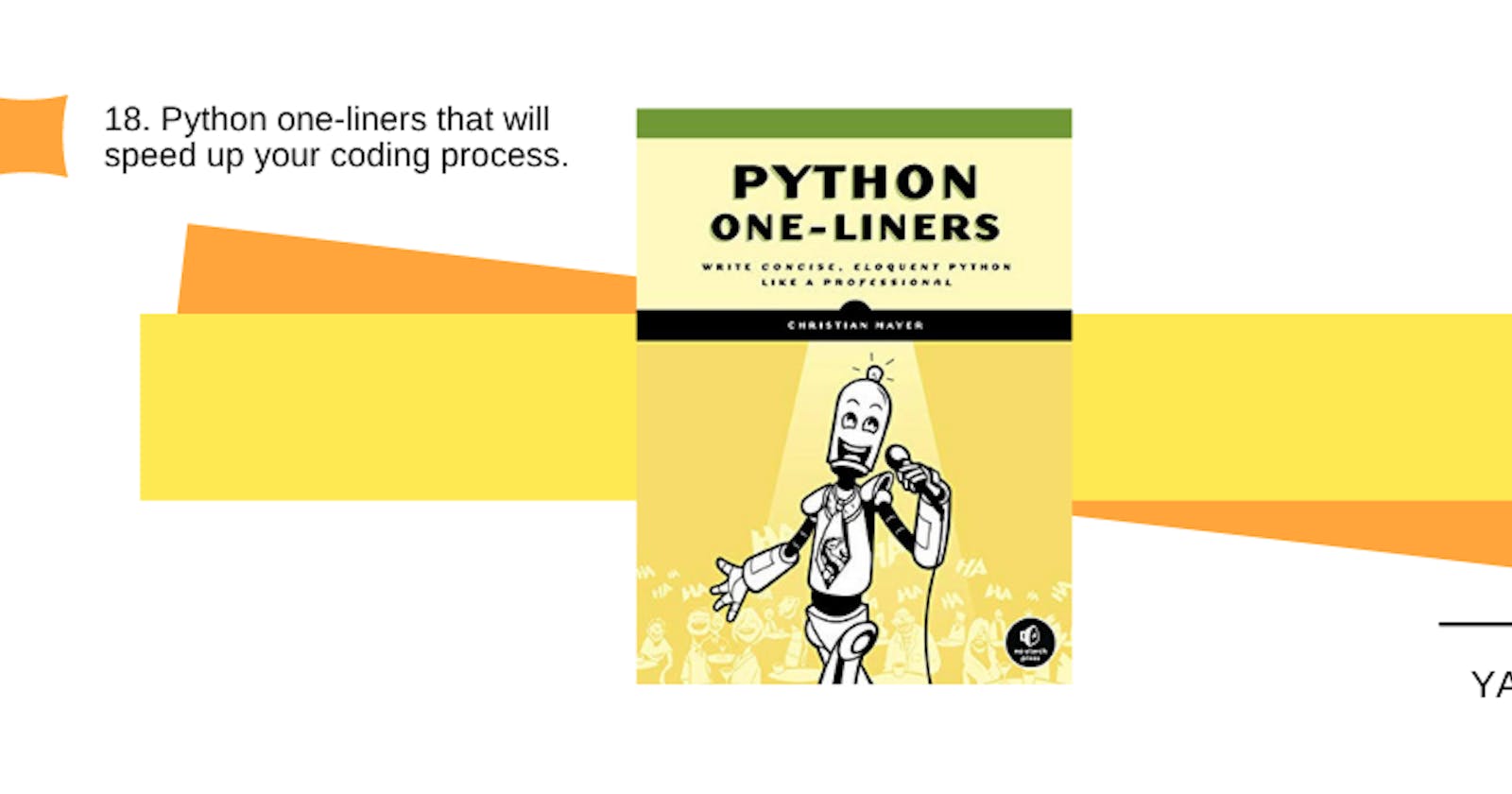Hi folks, I am Yash Makan and in today's blog, we are going to talk about one-liners in python. I clearly remember when I chose to learn python it was just beacuse of the simplicity and readability. But you know what you can make the python code even more easy with less lines of code. Yup! thats right my frined. These one-liner code can save you a lot of time, memory and can impress your friends...

what is a one-liner code?
You can think of one-liner code as a block of code compressed together so that it fits inside one line. It is the concise, useful programs packed in just one single line.
why do I need them?
So if you are not a big fan of writing one-liners or you are just curious that why do I have to know these then below are some pretty convincing topics.
- Understanding One-liners will make a python expert as you will get a much better understanding of the language.
- This will help you to write the code faster. You can write the piece of code much faster than others which will help you in competitive programming.
- On-liners will improve your basics and roots of programming as they strengthen your basics.
- You will write the code more in a pythonic way. Generally, people who come from different languages often write code in an un-pythonic way in python for example they don't use list comprehension, multiple assignments, and slicing etc.
- You can impress your friends, colleagues and you can give a good impression in your interview if you have a good grasp of one-liners.
But also it can be a little hard as well. Imagine programming as chess. You know the basics is like knowing what is variables, loops, conditions, data structures, classes but learning the master movies and creating your own strategy is like one-liners. In the beginning, it can be hard and quite overwhelming but once you get to know them. You can achieve greatness and win matches faster than a lot of other players. Everything has a price to pay my friend...
Basics
1. If-else
Before
if 3 < 2:
var=21
else:
var=42
After
var = 21 if 3<2 else 42
2. Elif
Before
>>> x = 42
>>> if x > 42:
>>> print("no")
>>> elif x == 42:
>>> print("yes")
>>> else:
>>> print("maybe")
yes
After
>>> print("no") if x > 42 else print("yes") if x == 42 else print("maybe")
yes
3. If without else
Before
condition = True
if condition:
print('hi')
After
if condition: print('hello')
print('hello') if condition else None
4. Function
Before
def f(x):
return "hello "+ x
After
f = lambda x: "hello "+ x
f = exec("def f(x):\n return 'hello '+ x")
5. Loop
Before
squares = []
for i in range(10):
squares.append(i**2)
After
squares=[i**2 for i in range(10)]
6. Loop with If
Before
squares = []
for i in range(10):
if i%2==0:
squares.append(i**2)
After
squares = [i**2 for i in range(10) if i%2==0]
7. Loop with if else
Before
squares = []
for i in range(10):
if i%2==0:
squares.append(i**2)
else:
squares.append(False)
After
squares = [i**2 if i%2==0 else False for i in range(10)]
8. While Loop with if else
Before
c=0
while c < 10:
if c!=5:
print(c)
else:
print("FIVE")
c+=1
After
while c < 10: c+=1; print(c) if c!=5 else print("FIVE")
9. swap variables
Before
>>> def swap(x,y):
x = x ^ y
y = x ^ y
x = x ^ y
return x, y
>>> swap(10,20)
(20,10)
After
>>> x, y = 10, 20
>>> x, y = y, x
(20, 10)
10. Multiple Assignment
Before
a="ONE"
b=2
c=3.001
After
a, b, c = "One", 2, 3.001
11. Write String In File
Before
text = "Helllloooooo"
fileName = "hello.txt"
f=open(fileName, "a")
f.write(text)
f.close()
After
text = "Helllloooooo"
fileName = "hello.txt"
print(text, file=open(fileName, 'a'))
12.Quicksort
Before
# Source - https://stackabuse.com/quicksort-in-python/
def partition(array, start, end):
pivot = array[start]
low = start + 1
high = end
while True:
while low <= high and array[high] >= pivot:
high = high - 1
while low <= high and array[low] <= pivot:
low = low + 1
if low <= high:
array[low], array[high] = array[high], array[low]
else:
break
array[start], array[high] = array[high], array[start]
return high
def quick_sort(array, start, end):
if start >= end:
return
p = partition(array, start, end)
quick_sort(array, start, p-1)
quick_sort(array, p+1, end)
array = [29,99,27,41,66,28,44,78,87,19,31,76,58,88,83,97,12,21,44]
quick_sort(array, 0, len(array) - 1)
print(array)
After
array = [29,99,27,41,66,28,44,78,87,19,31,76,58,88,83,97,12,21,44]
q = lambda l: q([x for x in l[1:] if x <= l[0]]) + [l[0]] + q([x for x in l if x > l[0]]) if l else []
print(q(array))
13. Fibonacci
Before
def fib(x):
if x <= 2:
return 1
return fib(x - 1) + fib(x - 2)
After
fib=lambda x: x if x<=1 else fib(x-1) + fib(x-2)
14. HTTP Server
Before
import http.server
import socketserver
PORT = 8000
Handler = http.server.SimpleHTTPRequestHandler
with socketserver.TCPServer(("", PORT), Handler) as httpd:
print("serving at port", PORT)
httpd.serve_forever()
After
python -m http.server 8000
15. Nested For Loops
Before
iter1 = [1, 2, 3, 4]
iter2 = ['a', 'b', 'c']
for x in iter1:
for y in iter2:
print(x, y)
After
[print(x, y) for x in iter1 for y in iter2]
16. Print Without Newline
Before
for i in range(1,5):
print(i, end=" ")
After
print(*range(1,5))
17. Class
Before
class School():
fun = {}
After
School = type('School', (object,), {'fun':{}})
18. Walrus:= (Python 3.8)
Before
command = input("> ")
while command != "quit":
print("You entered:", command)
After
while (command := input("> ")) != "quit": print("You entered:", command)
Conclusion
So now you have some understanding of python one-liners and this will help to speed up your coding process. I hope that you've learnt something new from this article as I myself get to know some cool tricks and one-liners that I didn't know earlier. If this is the case with you as well then do click the heart button when increases my motivation(1 like = 1 good karma). Also, share the post with your friends so that they too can learn something new(don't be selfish...). Hope to be in your mind again, till then b-bye!

